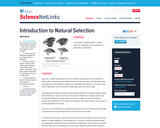
This parent guide supports parents in helping their child at home with the 8th grade Science content.
- Subject:
- Science
- Material Type:
- Reference Material
- Vocabulary
- Author:
- Kelly Rawlston
- Letoria Lewis
- Date Added:
- 10/11/2022

This parent guide supports parents in helping their child at home with the 8th grade Science content.

This resource accompanies our Rethink 8th Grade Science course. It includes ideas for use, ways to support exceptional children, ways to extend learning, digital resources and tools, tips for supporting English Language Learners and students with visual and hearing impairments. There are also ideas for offline learning.

In this lesson, students explain genetic variation and natural selection and describe how an organism with traits better suited for their environment is more likely to survive.

This resource is a lesson plan in which students will use clues from bird beaks and feet to design a bird. They will then write about the environment of that bird and how its structures enable it to survive.

Students watch a video of a gliding lizard to examine characteristics that enable flight. They record in chart form characteristics and abilities of four pterosaurs to see how these animals adapted to survive over millions of years.

CK-12's Life Science delivers a full course of study in the life sciences for the middle school student, relating an understanding of the history, disciplines, tools, and modern techniques of science to the exploration of cell biology, molecular biology, genetics, evolution, prokaryotes, protists,fungi, plants, animals, invertebrates, vertebrates, human biology, and ecology. This digital textbook was reviewed for its alignment with California content standards.

This activity serves as an extension to the HHMI short film The Making of the Fittest: Natural Selection and Adaptation and a means of reinforcing the concepts of variation and natural selection. Students will examine 8 snapshot samples from rock pocket mouse populations (4 snapshots at each of 2 different locations). By counting the number of light and dark-colored mice present at each location, they will determine the correct order of the snapshots from oldest to most recent. They will then graph their results and write a scientific summary describing one of the mouse populations and how it has changed over time.

Students are introduced to natural selection, specifically how it unfolds from generation to generation.

Students will consider an imaginary scenario in which changes in an environment may impact the survival of a population of Easter bunnies.

This resource explains why those with sickle cell anemia will not contract malaria.

This resource will allow you to determine how different traits offer a greater chance for an organism to survive.

This brief video excerpt, from Evolution: "Why Sex?", biologist Robert Vrijenhoek discusses the Red Queen hypothesis through the example of the Mexican Poeciliid fish. Vrijenhoek has been studying the Mexican Poeciliid fish for more than 30 years. Some species of Poeciliopsis reproduce sexually while others reproduce asexually. Vrijenhoek found that the genetic diversity produced by sexual reproduction allowed the sexual fish to survive a parasite more successfully than the asexual fish. Invoking the Red Queen hypothesis, Vrijenhoek suggests the sexual populations are able to keep up or adapt to new selective challenges, while the asexual populations, essentially clonal, are not. Supplemental resources, including a background essay and discussion questions, are also provided.

This course was created by the Rethink Education Content Development Team. This course is aligned to the NC Standards for 8th Grade Science.

This course was created by the Rethink Education Content Development Team. This course is aligned to the NC Standards for 8th Grade Science.

This course was created by the Rethink Education Content Development Team. This course is aligned to the NC Standards for 8th Grade Science.

This series of hands-on activities complements the HHMI DVD Evolution: Constant Change and Common Threads, and requires simple materials such as M&Ms, food storage bags, colored pencils, and paper cups. This activity has been designed to engage students in thinking about the mechanism of natural selection by encouraging them to formulate questions that can be answered through scientific investigation, data collection, and pattern recognition.